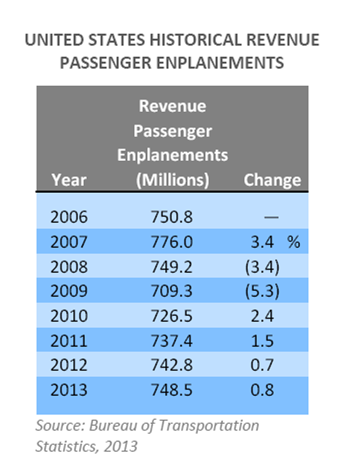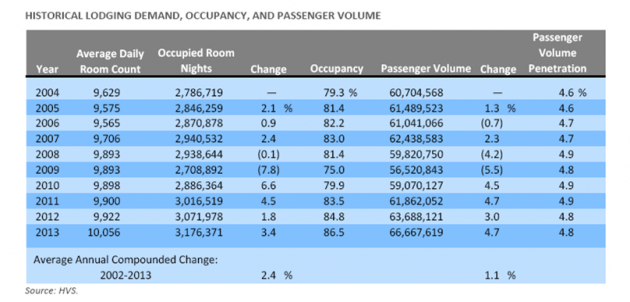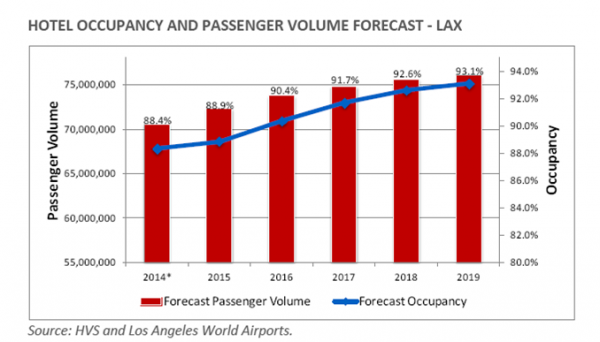By Jessica White / January 2015
With the expansion of major national airports and airport passenger volume expected to increase over the next 10 years, examining the link to forecasting lodging demand is critical to understanding the airport-hotel relationship. LAX provides an illuminating case study.
Airport passenger volume is a key performance indicator for an area’s lodging market and tourism economy at large. According to the Federal Aviation Administration (FAA), 31 airports are undergoing renovation or expansion (https://nfdc.faa.gov/xwiki/bin/view/NFDC/Construction+Notices), including major gateway city airports such as Boston-Logon, O’Hare, and Los Angeles (LAX). Additionally, passenger enplanements are forecast to increase 15% to approximately 857.4 million by 2020, according to the FAA’s Terminal Area Forecast database (http://aspm.faa.gov/apowtaf/). With many of the nation’s airports expanding and passenger volume forecast to register robust growth, it is important to understand how passenger volume can aid lodging demand forecasting. As a tool to understand this relationship, let’s look at a case study of the Los Angeles International Airport (LAX).
CASE STUDY: LOS ANGELES INTERNATIONAL AIRPORT (LAX)
LAX is one of the busiest airports in the nation and the gateway to Southern California. The airport is currently in the midst of a multi-billion-dollar renovation expected to continue through 2019. In 2013, the first phase (and centerpiece of the modernization) of the $1.9 billion Thomas Bradley Terminal was completed. Prior upgrades include the $175 million construction of Taxilane S, completed in 2011 and the $238 million renovation of Terminal 6, completed in 2012. Current projects include the $613 million baggage handling and screening system modernization occurring across all nine terminals and the $229 million renovation of Terminal 5, scheduled for completion in late 2015. In December 2014 the Los Angeles Board of Airport Commissioners approved two new major projects. The first project is the $4 billion airport transportation project that will help passengers move from airport terminals to a new Rental Car Center and the new Los Angeles Metro Crenshaw Line; construction is anticipated to begin in 2017. The second project is the new 5-level Midfield Satellite Concourse, which will add 11 gates to LAX and accommodate large aircrafts such as the Airbus A380 and the Boeing 787 Dreamliner.
Historical Lodging Demand and Passenger Volume
Lodging facilities are a critical component of an airport’s success. Guestrooms for transient visitors, distressed passengers, and airline crews and meeting space support the popularity of particular airport destinations. Proximate to LAX are a number of hotels north and south of the terminals. For the purposes of this article, the airport hotel market is defined as hotels located in the immediate LAX area (zip code 90045) and hotels located to the south of LAX in the city of El Segundo (zip code 90245). This market currently offers 27 hotels ranging from economy limited-service hotels to first-class full-service hotels.
The following chart outlines the historical lodging demand, occupancy, airport passenger volume, and airport passenger volume penetration (passenger volume includes enplanements and deplanements).
Passenger volume at LAX has steadily improved in recent years concurrent with the recovery of the local and national economy, the addition of flights, and the advent Boeing 787 Dreamliner in 2012. Several airlines recently added new flights to and from LAX. Etihad Airways debuted LAX service to Abu Dhabi in July 2014; United launched nonstop service to Melbourne, Australia in October 2014; and several airlines such as Southwest, Virgin, and Delta expanded the number of flights on current routes. Flight additions planned for 2015 include American Airlines’ addition of nonstop service to Atlanta; Japan Airlines new daily service to Osaka Japan; Ethiopian Airlines to launch service to LAX with the Boeing 787 Dreamliner; and United’s Boeing 787 Dreamliner service to Shanghai, China.
In addition to the renovation and expansion at LAX, growth in international arrivals is expected to buoy demand, particularly from China. In 2013, 818,000 Chinese visitors arrived to California and collectively spent $1.9 billion (http://industry.visitcalifornia.com/media/uploads/files/editor/Visitors%20to%20CA%20from%20China%202013.pdf). This represents a 45.3% market share of total U.S arrivals from China. The number of visitors from China to California is expected to increase due to the growth of the Chinese middle class and easing of visa restrictions. In 2012, 83 million Chinese traveled internationally, an 18 percent increase over the previous year. The number of Chinese traveling abroad is expected to reach 100 million by 2015 and 200 million by 2025 (http://industry.visitcalifornia.com/Market-Strategy/International-Markets/China/). As a result, passenger volume growth at LAX is anticipated to be robust over the next several years as forecast by Los Angeles World Airports.
Forecast Lodging Demand and Passenger Volume
Although lodging demand and occupancy has fluctuated during the historical period reviewed, the passenger volume penetration index has remained within a relatively small range between 4.6 and 4.9 (passenger volume penetration index is calculated as the number of occupied room nights divided by passenger volume). Based on the projected passenger volume provided by Los Angeles World Airports and a selected penetration index of 4.6, occupied room nights and occupancy were forecast for the market. With the expansion of passenger traffic, the hotel market is anticipated to be undersupplied. A new Residence Inn Los Angeles LAX Century Boulevard is anticipated to open in February 2015. This 231-room hotel is an office building conversion and will be the first new hotel directly on Century Boulevard since 1992. Taking into account the addition of the Residence Inn Los Angeles LAX Century Boulevard in February 2015, occupancy in the market is forecast to register steady growth overtime. With continued growth in demand from airport activity, hotel guests are expected to seek accommodations outside the immediate area. With the exception of the new Residence Inn, additional hotel supply appears to be limited. High barriers to entry, limited new supply, and increased passenger volume have and are expected to continue to support the high occupancy levels in the market.
CONCLUSION
This forecasting analysis can be considered for other airport markets based on historical demand and passenger volume. While not an exact science, it can aide hoteliers and developers in understanding the relationship between passenger volume and lodging demand to give a guideline for understanding airport markets’ occupancies.






